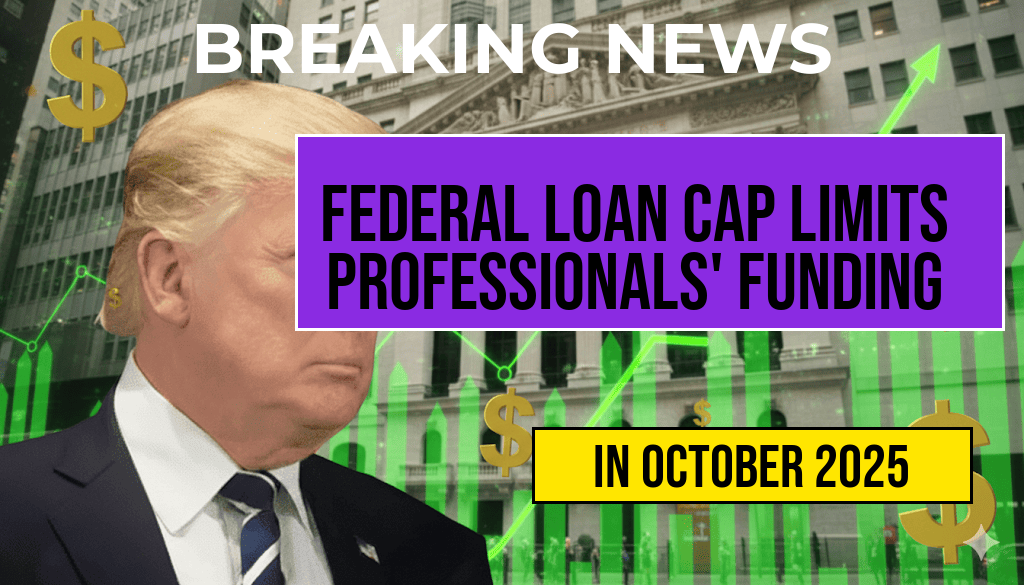The U.S. federal government has introduced new regulations that will significantly affect student loan borrowing limits for medical and legal professionals. Starting in 2023, doctors and lawyers will be restricted to borrowing a maximum of $50,000 annually, with a lifetime cap set at $200,000 by 2026. These changes aim to address the growing concerns surrounding student debt, particularly among graduates in high-cost educational fields. As higher education costs continue to rise, the implications of these limits could reshape the financial landscape for aspiring medical and legal professionals, leading many to reconsider their educational paths and financing strategies.
Understanding the New Federal Loan Caps
The recently implemented loan caps are part of a broader initiative to manage federal student loan programs effectively. The Department of Education has indicated that these changes are necessary to ensure sustainability within the federal student loan system.
Details of the Loan Caps
- $50,000 Annual Limit: Professionals in the medical and legal fields can borrow up to $50,000 each academic year.
- $200,000 Lifetime Cap: The total amount that can be borrowed throughout the entirety of a professional’s education is capped at $200,000.
Impact on Medical and Legal Education
The implications of these caps are profound. Medical and law school tuition has surged over the past decade, often exceeding $60,000 annually at top institutions. As a result, many students have relied on federal loans to finance their education, accruing large amounts of debt. The new limitations may force prospective students to explore alternative funding options such as private loans, scholarships, or part-time employment.
Moreover, with the growing trend of tuition-free community colleges and state universities, the need for federal loans may decrease for some students. However, for those pursuing advanced degrees, the caps could create substantial financial barriers.
Reactions from the Affected Professions
Responses from educators and industry professionals have been mixed. Many in the medical and legal communities are expressing concern about the long-term viability of their professions in light of these new restrictions. Some argue that the caps may deter potential students from entering these fields, exacerbating existing shortages.
Concerns Over Workforce Shortages
Healthcare and legal professional organizations are warning that limiting access to financial resources could lead to a decreased number of graduates in critical fields. For instance, the American Medical Association (AMA) and the American Bar Association (ABA) have both raised alarms about the potential impact on future workforce numbers.
Alternatives for Financing Education
As students navigate these new limits, alternative financing methods are becoming increasingly important. Here are some options that those affected might consider:
- Private Loans: While often carrying higher interest rates, private loans may provide more flexibility in borrowing amounts.
- Scholarships and Grants: Many organizations offer funding specifically for medical and legal students, which do not require repayment.
- Income-Driven Repayment Plans: These plans can help manage debt post-graduation, adjusting payments based on income.
Future Considerations
As the new federal loan caps take effect, both students and educational institutions must adapt to this evolving financial landscape. The long-term consequences of these regulations could alter the dynamics of professional education, potentially leading to fewer graduates in essential fields. Stakeholders are encouraged to engage in ongoing discussions about the viability of these caps and their effects on workforce development.
For more information on the implications of these changes, individuals can refer to the Forbes article on federal student loan limits and the Wikipedia page on student loans.
Frequently Asked Questions
What are the new federal loan cap limits for doctors and lawyers?
The new federal loan cap limits for doctors and lawyers are set at $50,000 annually, with a total cap of $200,000 by 2026.
How will the loan cap impact medical and legal education?
The loan cap may limit the amount of financial support available to students pursuing medical and legal education, potentially affecting their ability to cover tuition and related expenses.
When will these loan cap limits take effect?
The limits on federal loans for doctors and lawyers will take effect immediately, with the annual cap at $50,000 and the total cap reaching $200,000 by 2026.
Are there any exceptions to the loan cap for medical and legal professionals?
As of now, there are no specified exceptions to the loan cap for medical and legal professionals, meaning all borrowers will be subject to the same limits.
What are the implications of these loan caps on future graduates?
The implications of these loan caps could lead to increased financial strain on future graduates in the medical and legal fields, potentially influencing their career choices and the types of institutions they attend.






